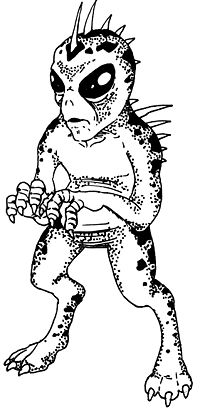تشوپاكابرا
 صورة من المعتقد بان تشوپاكابرا قد يكون على هذا الشكل | |
| Creature | |
|---|---|
| Grouping | Cryptid |
| Data | |
| First reported | مارس 1995 |
| Last sighted | 2009 |
| Country | پويرتو ريكو المكسيك الولايات المتحدة |
| Region | أمريكا الوسطى والشمالية |
| Status | Unconfirmed |
| جزء من سلسلة مقالات عن |
| الخوارق |
|---|
تشوپاكابرا ((بالإسبانية: Chupacabra)؛ النطق الإسپاني: [tʃupaˈkaβɾas]؛ تعني مصاص دماء الماعز وتشوپا Chupa تعني يمص، و كابرا Cabra تعني ماعز لذا يعني مصاص الماعز. وهو معروف كحيوان غير محدد لعلم الحيوان. The name comes from the animal's reported vampirism—the chupacabra is said to attack and drink the blood of livestock, including goats.
Physical descriptions of the creature vary, some describe it as reptilian and alien-like (in Puerto Rico and Latin America), generally as a heavy creature the size of a small bear with a row of spines reaching from the neck to the base of the tail. Others depict it as more dog-like (particularly in Southwestern United States).
Sightings, and the initial descriptions, were first reported in Puerto Rico in 1995. The creature has since been reported as far north as Maine, as far south as Chile, and even outside the Americas in countries like Russia and Philippines. All of the reports are anecdotal and have been disregarded as uncorroborated or lacking evidence. Sightings in northern Mexico and the southern United States have been verified as canids afflicted by mange.[1] According to biologists and wildlife management officials, the chupacabra is an urban legend.[2]
الاسم
Chupacabras can be literally translated as 'goat-sucker', from chupar ('to suck') and cabras ('goats'). It is known as both chupacabras and chupacabra throughout the Americas, with the former being the original name,[3] and the latter a regularization. The name is attributed to Puerto Rican comedian Silverio Pérez, who coined the label in 1995 while commenting on the attacks as a San Juan radio deejay.[4][5]
تاريخ
في 1975، يقتل الحيوانات في المزارع موكا، پوِرتو ريكو. ولقب بهذا الاسم من بعد أن عثر على عدد من الماعز ميتة وعلامات الأنياب في رقابها مما يدل على مص دمائها.
الحالات
نشرت مجلة (يو اف او) في مارس/أبريل 1996 أن هناك أكثر من 2000 حالة مماثلة لحالة الماعز في بورتو ريكو في أمريكا الجنوبية، الوسطى والشمالية، وفي جميع الحلات لم يتم القبض على الوحش شوبا-كبرا أو تصويره.
الظهور
جيميع الشهود يتوافقوا على أن شوبا-كبرا "إنه حيوان بشع للغاية، له رأس حيوان ثديي وأذنان كبيرتان وأنياب طويلة معقوفة ولونه أزرق ضارب إلى الرمادي، ولا يكسوه الشعر أو الفرو يمشي على أربعة اقدام "
انظر أيضاً
مراجع
- ^ Radford, Benjamin (2011). Tracking the Chupacabra: The Vampire Beast in Fact, Fiction and Folklore. ISBN 978-0-8263-5015-2.
- ^ González Rodríguez, Miried (24 September 2002). "Disfrazado el chupacabras" [Disguised as chupacabras]. Primera Hora (in الإسبانية). Puerto Rico. Archived from the original on 25 April 2018. Retrieved 25 April 2018.
- ^ "chupacabras". Diccionario Clave. Archived from the original on 4 March 2016. states that both singular and plural is chupacabras.
- ^ Pérez, Silverio (2000). Más humortivación: para el camino del éxito [More Humortivation: The Path for Success]. Dreams Come True. p. 7. ISBN 978-0-9702011-0-2.
- ^ Radford, Benjamin (1 June 2017). "Was the Nightjar an Early Chupacabra?". Center for Inquiry. Archived from the original on 14 September 2019.
وصلات خارجية
- Alleged chupacabra likely a "Xolo dog"; story a hoax
- Lundborg, Pam (25 September 2009). ""Chupacabra" remains bought by Oswego County man". Syracuse.com. Retrieved 20 January 2016.
- Chupacabra mystery solved from Seeker.com
- Ooty: Kangaroo cousin lived in western ghats?
- Dunning, Brian (22 January 2022). "Skeptoid #815: On the Trail of the Chupacabra". Skeptoid. Retrieved 14 May 2022.